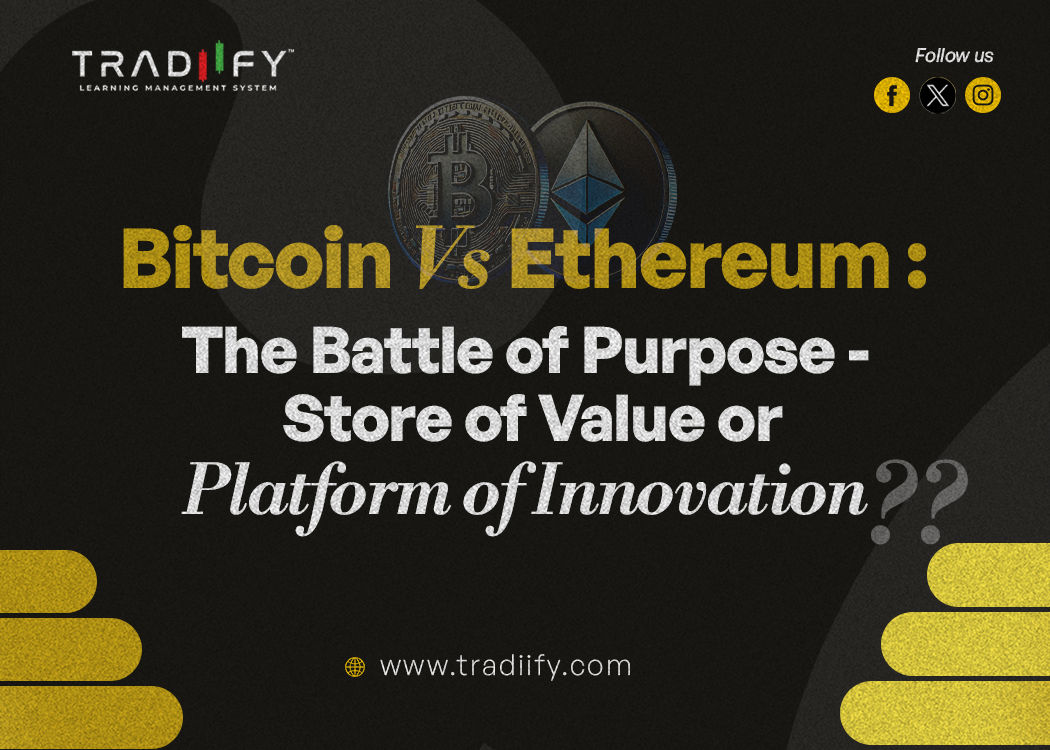
Bitcoin vs Ethereum: The Battle of Purpose — Store of Value or Platform of Innovation?
The cryptocurrency world has matured from a fringe financial experiment into a trillion-dollar ecosystem reshaping how we perceive money, ownership, and innovation. At the center of this digital revolution stand two giants — Bitcoin and Ethereum.
Both use blockchain technology, operate without central authority, and share the goal of decentralization. Yet, they represent two fundamentally different visions for the future of digital finance. Bitcoin aims to preserve value; Ethereum aims to build new value.
This article explores their origins, philosophies, functions, and future potential — providing a clear understanding of what makes each a cornerstone of the crypto world.
1. The Origins: Two Visions, One Revolution
Bitcoin — The Beginning of Decentralized Money
Bitcoin was born in 2009, when an anonymous creator known as Satoshi Nakamoto published a whitepaper titled “Bitcoin: A Peer-to-Peer Electronic Cash System.” It proposed a revolutionary concept — money that could move freely between individuals without banks, governments, or middlemen.
The goal was to create a trustless system — one that replaced institutions with mathematics and cryptography. In the aftermath of the 2008 financial crisis, Bitcoin became a symbol of financial independence and transparency.
Over the years, Bitcoin evolved from being seen purely as digital currency into a store of value, often referred to as “digital gold.” Its limited supply of 21 million coins ensures scarcity, and its decentralized network makes it resistant to manipulation.
Bitcoin became not just a payment tool, but a monetary alternative — one that challenges traditional financial systems and inflationary fiat currencies.
Ethereum — The Programmable Future of Blockchain
Ethereum was launched in 2015 by Vitalik Buterin, who envisioned blockchain doing more than just transferring value. He wanted a system that could run code and execute agreements automatically — giving rise to the concept of smart contracts.
Smart contracts are self-executing digital agreements that eliminate intermediaries. This innovation transformed Ethereum into a decentralized computing platform, enabling developers to build DApps (decentralized applications) across industries — from finance and art to gaming and governance.
In simple terms, Bitcoin is digital money, while Ethereum is a digital economy.
Ethereum didn’t just introduce a new coin (ETH); it introduced a new way of building systems — open, programmable, and decentralized.
2.Core Philosophy: Stability vs. Flexibility
Bitcoin — Security and Simplicity
Bitcoin’s philosophy is rooted in simplicity, stability, and security. It focuses on doing one thing exceptionally well — storing and transferring value safely.
With a hard cap of 21 million coins, Bitcoin is inherently deflationary. This scarcity fuels its value proposition as a hedge against inflation and fiat currency depreciation.
Bitcoin’s network is secured through Proof of Work (PoW), where miners use computing power to validate transactions. While energy-intensive, it remains one of the most secure consensus mechanisms ever built.
The trade-off, however, is limited flexibility. Bitcoin’s codebase evolves slowly to maintain security, meaning it doesn’t easily support complex applications or upgrades.
Ethereum — Innovation and Evolution
Ethereum’s philosophy is the opposite — it embraces adaptability and experimentation.
It allows developers to create, test, and deploy decentralized applications, powering entire industries like DeFi (Decentralized Finance) and NFTs (Non-Fungible Tokens).
Unlike Bitcoin, Ethereum doesn’t have a fixed supply, giving it flexibility for network incentives and long-term development. It constantly evolves through major upgrades — most notably the shift from Proof of Work to Proof of Stake (PoS) in 2022, known as “The Merge.”
This upgrade made Ethereum 99% more energy-efficient and set the stage for future scalability improvements. Ethereum isn’t static — it’s a living network, always expanding its capabilities to match new possibilities.
3. Economic Role: Store of Value vs. Engine of Innovation
Bitcoin — The Digital Gold Standard
Bitcoin’s economic model mirrors that of gold — finite, mined, and valuable because of scarcity. Its predictable supply schedule and decentralized nature make it a preferred hedge against inflation and store of long-term value.
For investors, Bitcoin functions as a macro asset — a digital reserve that behaves like gold in times of uncertainty. Institutional investors, corporations, and even countries now include Bitcoin in their portfolios as part of diversification and inflation protection strategies.
Every Bitcoin mined represents a piece of digital scarcity backed by global consensus — not a central bank’s promise.
Ethereum — The Infrastructure of Web3
Ethereum, in contrast, operates as the infrastructure of digital innovation. Every transaction, contract, or decentralized application on its network uses Ether (ETH) as fuel, commonly referred to as “gas.”This economic design transforms Ethereum into a self-sustaining ecosystem, where usage directly drives demand. The more people build, transact, or experiment on Ethereum, the more valuable its underlying token becomes.
Ethereum’s introduction of EIP-1559, which burns a portion of transaction fees, added a deflationary element to its tokenomics — balancing supply while increasing scarcity over time.
In essence, Ethereum is not merely a currency — it is digital infrastructure powering the decentralized internet.
4. Strengths and Challenges
Bitcoin’s Strengths
Unmatched Security: Backed by one of the most powerful decentralized networks in the world.Predictable
Supply: Only 21 million coins, ensuring long-term scarcity.
Widespread Recognition: Considered the most trusted and recognized cryptocurrency globally.
Institutional Adoption: Seen as a legitimate asset class by major financial institutions.
Bitcoin’s Challenges
Limited Functionality: Cannot support smart contracts or decentralized apps.
Energy-Intensive Mining: Proof of Work consumes significant energy resources.
Slow Transactions: Lower throughput compared to modern blockchain solutions.
Ethereum’s Strengths
Programmable Blockchain: Supports a wide range of applications from DeFi to NFTs.
Large Developer Community: Thousands of active developers constantly improving the network.
Transition to Proof of Stake: Greater efficiency and environmental sustainability.
Continuous Innovation: Flexible framework that evolves through community-driven upgrades.
Ethereum’s Challenges
High Gas Fees: Network congestion can make transactions expensive.
Complex Ecosystem: Smart contracts are prone to coding errors and vulnerabilities.
Rising Competition: New blockchains like Solana and Avalanche are challenging Ethereum’s dominance.
Regulatory Uncertainty: Governments are still defining legal frameworks for DeFi and tokens.
5. Market Dynamics and Investor Outlook
Bitcoin and Ethereum attract different types of investors.
Bitcoin investors are often conservative, focusing on wealth preservation and the long-term narrative of digital gold. They see Bitcoin as a safe haven against economic instability and inflationary policies.
Ethereum investors, on the other hand, are innovation-oriented. They see Ethereum as exposure to the growth potential of blockchain technology — particularly in DeFi, Web3, and decentralized applications.
While Bitcoin provides stability and scarcity, Ethereum offers utility and scalability. Together, they account for nearly 70% of the total crypto market capitalization, making them the twin pillars of the digital asset space.
6. The Future: Coexistence Over Competition
The debate between Bitcoin and Ethereum often centers around which one will dominate. However, a more realistic view is coexistence rather than competition.
Bitcoin’s Future:
It will likely continue to strengthen its role as a store of value and reserve asset for both retail and institutional investors. Integration with Layer-2 solutions like the Lightning Network could improve transaction speed and scalability, making Bitcoin more practical for everyday payments.
Ethereum’s Future:
Ethereum is poised to drive the next phase of the internet — Web3. Its continuous upgrades will enhance scalability, reduce costs, and expand accessibility. As tokenized assets, smart contracts, and decentralized finance grow, Ethereum’s relevance will only deepen.
Both assets will shape the future financial landscape — Bitcoin by anchoring value, and Ethereum by expanding utility.
7. Key Takeaways
Bitcoin represents digital sound money — scarce, secure, and resistant to inflation.
Ethereum represents digital innovation — open, programmable, and transformative.
Bitcoin focuses on preservation, while Ethereum focuses on creation.
Both have distinct purposes, yet together, they form the foundation of the decentralized financial world.
Investors should view them as complementary assets — one providing security, the other delivering growth potential.
8.The Tradiify Perspective
At Tradiify, we believe financial education is about understanding purpose before price. Bitcoin and Ethereum symbolize two philosophies that redefine how individuals think about money, investment, and technology.
Bitcoin teaches the value of scarcity and trust. It embodies financial discipline and the importance of holding assets that resist inflation.
Ethereum teaches the power of innovation and adaptability. It demonstrates how technology can democratize finance and create new economic models.
Together, they represent the evolution of finance — from centralized systems to community-driven ecosystems where transparency, ownership, and innovation coexist.
Final Thought:
The question isn’t whether Bitcoin will replace Ethereum or vice versa. The real question is how both will reshape the global economy in their own ways. Bitcoin preserves wealth; Ethereum enables creation.
In the end, it’s not a battle for dominance but a partnership of purpose — one that defines the very future of digital finance.
#Bitcoin #Ethereum #Blockchain #CryptoEducation #FinancialLiteracy #Tradiify #Investing #DigitalAssets #Innovation #WealthManagement
Comments (0)
Categories
Recent posts


Getting Started with Tradiify LMS: A ...
1 Aug 2024.jpg)
How Tradiify LMS Supports Continuous ...
1 Aug 2024
5 Ways an LMS Can Revolutionize Your ...
1 Aug 2024




